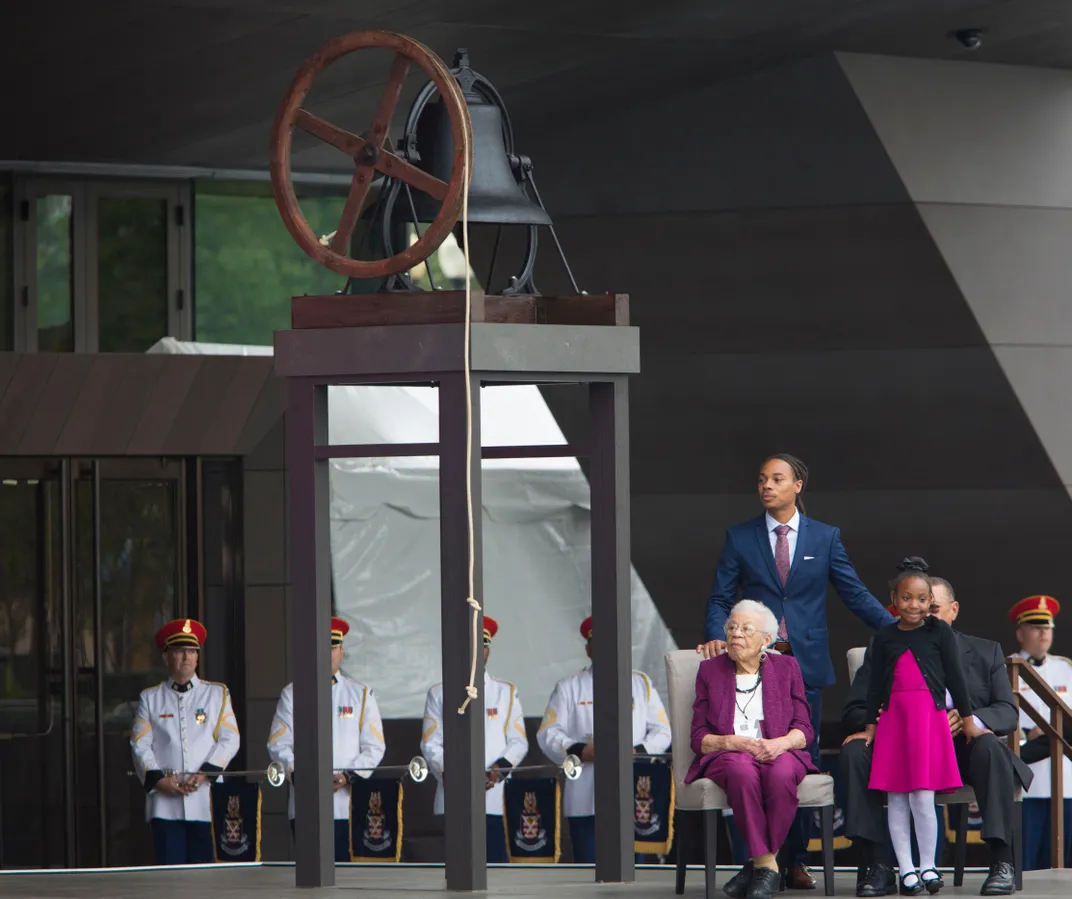Ruth Odom Bonner, Who Rang the Freedom Bell With President Obama, Passes Away at 100
Looking back on the redoubtable woman who helped inaugurate the African American History Museum
/https://tf-cmsv2-smithsonianmag-media.s3.amazonaws.com/filer/e6/91/e69173f8-1de5-4fc0-ba11-e4f9bdd62bfc/photograph_by_leah_l_jones_for_the_nmaahc_llj_330.jpg)
On the morning of September 24, 2016, 99-year-old Ruth Odom Bonner made her way to the lobby of her hotel in the company of close family members. Together, the group represented four generations of African Americans. They had been invited by church friend Cheryl Johnson to participate in the dedication ceremony for the National Museum of African American History and Culture, which Johnson was to play a part in overseeing.
Ruth Bonner’s father, Elijah Odom, was born a slave, and spent the earliest years of his life toiling in the Mississippi heat. Miraculously, though, he quickly managed to escape, and decided to capitalize on his newfound freedom by training to become a physician at a school devoted to medicine and dentistry.
Odom wound up in a small Arkansas town, where he established a general store. He took pains to set up his own office at the rear of the shop, so he could receive patients during business hours. Odom and his wife impressed upon young Ruth a no-nonsense work ethic, which would serve her well during the Civil Rights Era, when she became a prominent voice in the Cleveland, Ohio, political scene. She’d moved to Cleveland for a formal education, following in her father’s footsteps.
Doubtless these memories were racing through Ruth Bonner’s mind as she and her descendants waited curbside for their driver. Once the group arrived at the site of the museum and were escorted backstage, they soon found themselves in the company of legends. Ruth Bonner traded stories with Congressman John Lewis, actor Will Smith, and philanthropist Oprah Winfrey. As the adults readied themselves for the commencement of the festivities, Ruth’s great-granddaughter played games with Robert De Niro’s daughter.
The crowning moment was when Ruth Bonner was summoned onstage to join President Barack Obama for the ringing of the Freedom Bell, a priceless emblem of African-American resilience that had for over 125 years occupied the belfry of Williamsburg, Virginia’s historic First Baptist Church. (The church itself was founded by African Americans in 1776, in defiance of local law.) Though it had lost its voice during the Jim Crow Era by virtue of damage and neglect, the bell was refurbished in advance of the Smithsonian ceremony, and was ready to sing once more.
As Ruth Bonner and President Obama rang the bell, they were joined by countless others, both in and out of earshot, harmonizing with them in solidarity. “Obviously, we could only hear the ones around the city,” ceremony organizer Tasha Coleman recalls. “But we did have other partners and co-celebrators around the country and even beyond with us during this moment.”

Afterwards, Ruth joyfully made the acquaintance of yet more notables, this time including former executive Bill Clinton and the soulful Stevie Wonder. “Some of them even stood in line to talk to her,” says her son Mike Bonner, who also had a chance to ring the bell that day. “She was exhilarated.”
Standing there together onstage, the four-generation family was an inspiration to the assembled crowd. To Coleman, heritage and family ties were always vital to the mission of the museum. She says the example set by the Bonners has led many subsequent museum-goers to bring their own families along.
“It’s interesting to see the conversations that are happening between the great-grandmothers and the great-grandchildren when they recognize moments and stories that are in the museum that were personal to them,” Coleman says. “It’s really sparked dialogue.”
For Ruth Bonner, the whole experience was like a delirious, wonderful dream.
“She was overwhelmed to an extent,” says Mike Bonner, “but she really and truly enjoyed and was taken by the opening. And when she got back to her assisted living facility, they waited for her, and they clapped for her at the door, and just treated her like a rock star. It was really something to see.”
Ruth Bonner died peacefully on August 25, 2017. Her son recalls that Ruth’s magical day—the day of the museum’s opening ceremony—remained “vivid” in her mind until the very end.
“Even [just] before she passed,” he says, “when I would show her pictures of the opening, she would brighten up, and start smiling, and talk about it.”
UPDATE 11/09/2017: A previous version of this article implied that Ruth Bonner's father Elijah Odom had spent decades enslaved in Mississippi. In actuality, he was born a slave in 1859, just prior to the outbreak of the Civil War, and escaped bondage as a small child.
/https://tf-cmsv2-smithsonianmag-media.s3.amazonaws.com/accounts/headshot/DSC_02399_copy.jpg)
/https://tf-cmsv2-smithsonianmag-media.s3.amazonaws.com/accounts/headshot/DSC_02399_copy.jpg)